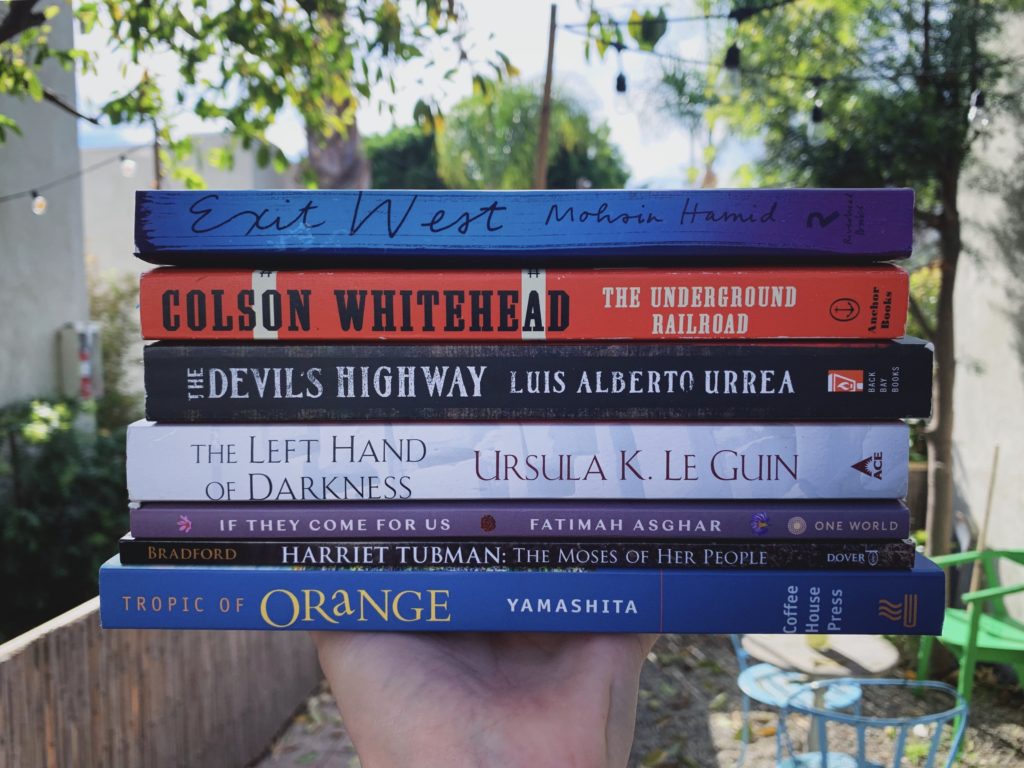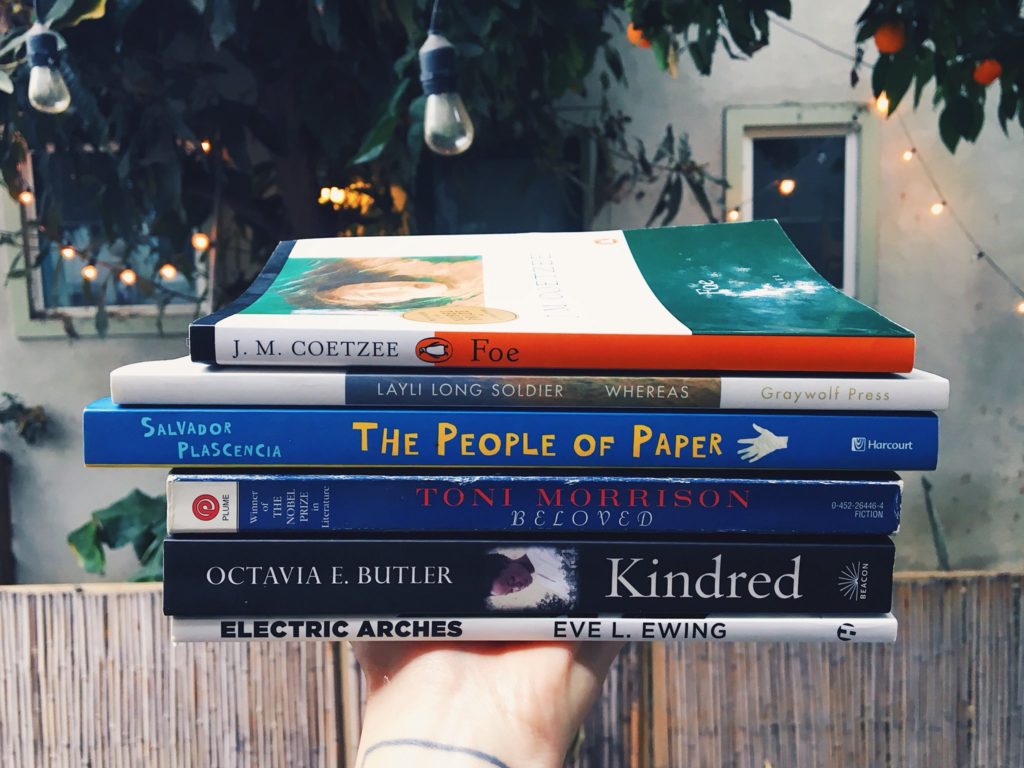Below are course descriptions and reading lists for the honors writing courses I have designed and taught at the University of Southern California. These classes are primarily multimedia and literature-based courses that address a specific cultural theme. A couple of the courses are accompanied by links to Twitter threads that document class discussion over the course of the semester.

I Pledge Allegiance
Course Description
“Ask not what your country can do for you/ask if your country is your country,” writes poet Danez Smith in response to JFK’s famous line beginning with the same phrase. Smith’s reversal pushes us to consider: When you pledge allegiance to the flag, what is it that you’re pledging allegiance to? An expanse of earth marked by geological or invented borders? A government? An idea we call Nation? In what ways do the borders, government, or nation pledge themselves to you? And if not borders, government, or the idea of a nation, who else might you declare your allegiance to? Your communities, your families, the land, yourselves?
In this course, we will trace ideas of allegiance across multiple texts. First, we follow the narrator of Justin Torres’s coming of age novel We the Animals as he navigates poverty, queerness, and being the son of a white mother and a Puerto Rican father. Then we will turn to Mohsin Hamid’s novel Exit West where we will meet two characters fleeing civil war in an unnamed area of West Asia in search of somewhere to settle down and someone to settle with. We will look at Claudia Rankine’s book-length poem Citizen and the multi-textual ways in which it asks and answers what it means to be Black in America. Finally, we will end with Louise Erdrich’s novel Future Home of the Living God, which takes us on a journey with an Ojibwe narrator who seeks safety for herself and her unborn child with the help of her adoptive white parents and her Ojibwe relatives as the America she knows becomes a ever-more dangerous dystopia. Our reading of these texts will be accompanied by the films Parasite and The Last Black Man in San Francisco, where characters have to carefully consider their allegiances as a means of survival.
Along the way, we will read poems, a short story, and excerpts of Sara Ahmed to help us frame and examine questions of allegiance: where do your impulses toward allegiance come from? How do you build and maintain your allegiances? And what happens when your break from those entities you’ve pledge yourself to?
Required Books
- Torres, Justin. We the Animals. 2011. (ISBN: 9780594919803)
- Hamid, Mohsin. Exit West. 2017. (ISBN: 9780735212176)
- Rankine, Claudia. Citizen. 2014. (ISBN: 9781555976903)
- Erdrich, Louise. Future Home of the Living God. 2017. (ISBN: 9780062695338)
- Additional readings will include poems by Nabila Lovelace, Safia Elhillo, Fatimah Asghar, Hazem Fahmy, & Michael Kleber-Diggs, plus excerpts from the work of Sara Ahmed, Frantz Fanon, & Kiese Laymon
Required Film/Television/Media
- Dir. Bong Joon-ho. Parasite (2019)
- Dir. Kristen Lester. “Purl.” (2019)
- Dir. Joe Talbot. The Last Black Man in San Francisco (2019)
- “You’re a Grand Old Flag” episode of NPR’s Code Switch (2016)
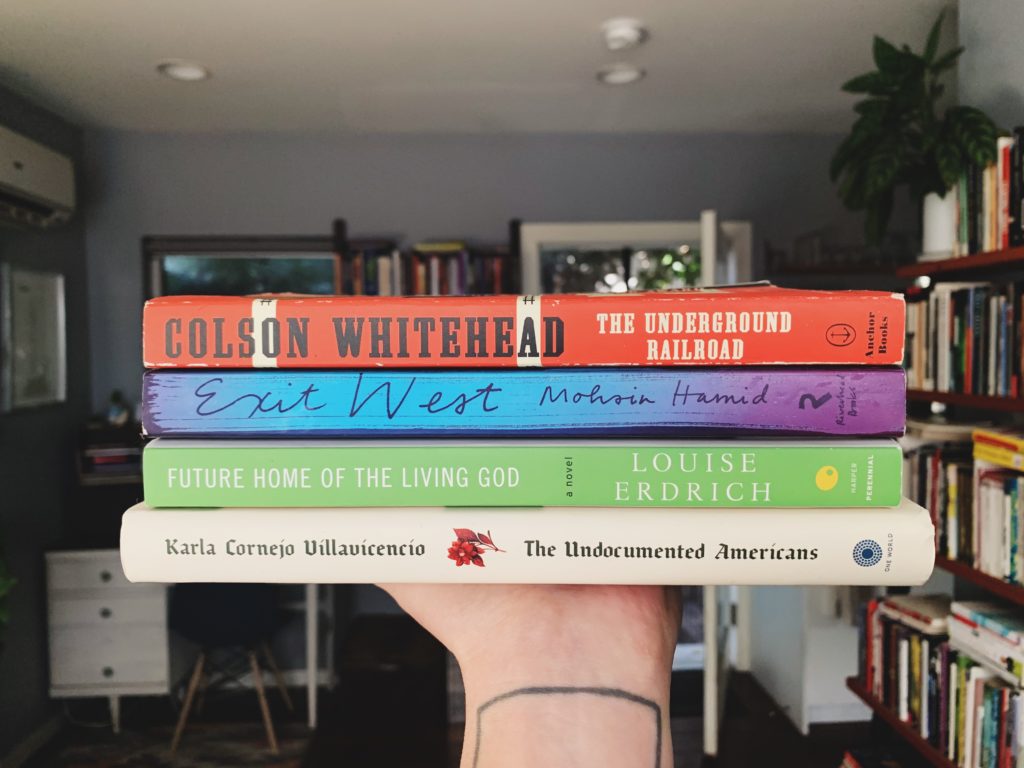
Undergrounds
Course Description
Basements, tunnels, secret passageways—entire worlds of movement and space exist just below our feet. These kinds of underground spaces have been used to hide fugitives fleeing the law, Jews and other persecuted groups fleeing Nazi’s, immigrants fleeing one country for another, and enslaved people fleeing slavery for freedom. But not all undergrounds exist solely under the ground. Some undergrounds exist out in the open, hidden in plain sight.
In this course, we will follow a young pregnant Ojibwe woman in Louise Erdrich’s Future Home of the Living God as she flees an increasingly oppressive and dangerous America, finding shelter and temporary safety in tunnels, warehouses, and disguises. Next, we’ll turn to Mohsin Hamid’s Exit West where two refugees find momentary homes on the outskirts of makeshift communities across the western hemisphere. Finally, we’ll read Colson Whitehead’s novel The Underground Railroad, an historical imagining of enslaved characters escaping slavery via a literal underground train, and Karla Cornejo Villavicencio’s essay collection The Undocumented Americans, which documents the life of immigrants living and working in America without papers. We’ll also watch films like Parasite and Us where the presence of literal undergrounds and figurative underground communities challenge us to consider what it truly means to live underground.
Our central texts will be accompanied by short essays from Assata Shakur, Robin D.G. Kelly, Gayatri Chakravorty Spivak, and others who will help guide us in exploring the thrills, fears, dangers, unknowns, and possibilities of living in and navigating underground worlds, whether those worlds are just below our feet or all around us.
Required Books
- Erdrich, Louise. Future Home of the Living God. 2017. (ISBN: 9780062695338)
- Hamid, Mohsin. Exit West. 2017. (ISBN: 9780735212176)
- Whitehead, Colson. The Underground Railroad. 2016. (ISBN: 9780385542364)
- Cornejo Villavicencio, Karla. The Undocumented Americans. 2020. (ISBN: 9780399592683)
- Additional readings will include poems by Roger Reeves, Franny Choi, & Ilya Kaminsky, plus excerpts from the work of Assata Shakur, Robin D.G. Kelly, Gayatri Chakravorty Spivak, Ragini Tharoor Srinivasan
Required Film/Television/Media
- Dir. Bong Joon-ho. Parasite (2019)
- Dir. Robert Findlay. “Change Return” (2020)
- Dir. Jordan Peele. Us (2019)
- “Liberté, Égalité And French Fries” episode of Rough Translation podcast (2019)
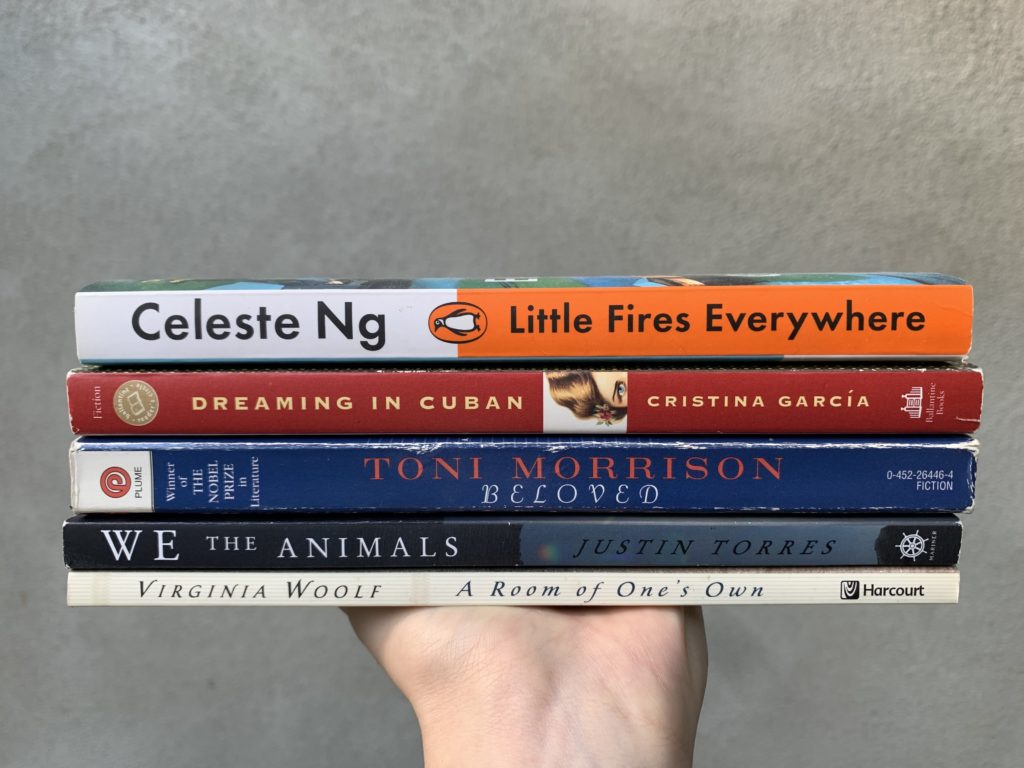
The Revolution Will Not Be Televised: Personal & Cultural Rebellion
Course Description
A teenage girl setting fire to every bed in her family’s home, a woman demanding a space of her own in a literary world run by men, a black man rewriting the history of his white San Francisco neighborhood to reclaim it as his own—acts of rebellion exist not just on a national scale, but in the small intimate moments of our everyday lives. Why might teenagers want to rebel against their families? How might those historically marginalized rebel against dominant culture? The rebellions we’ll explore sometimes disrupt families, neighborhoods, and cities. Other times they trigger revolution on a massive scale. But no matter how big or small the impact, rebellious acts can teach us about ourselves and the worlds against which we rebel.
In this course we will witness characters rebelling against their families, their communities, their nations, and themselves. We’ll start with Virginia Woolf’s seminal feminist text, A Room of One’s Own, and question what it means to rebel as a woman in a patriarchal society that does not afford all women the same opportunities. Then we’ll move to Toni Morrison’s Beloved and Christina García’s Dreaming in Cuban where characters rebel against the racial, economic, and political structures that violently shape their daily lives. And finally we’ll end with Justin Torres’ coming of age tale We the Animals and Celeste Ng’s Little Fires Everywhere to witness family members rebelling against their homes in an effort to define their own place in the world. Along the way, we’ll watch the 2019 film The Last Black Man in San Francisco about two black men trying to save their home from a changing neighborhood that threatens to destroy their sense of identity and read short stories by Nini Berndt and Flannery O’Conner that depict women who refuse to be defined by anyone but themselves.
Critical theorists like Sara Ahmed and other literary and cultural scholars writing on willful subjects, agency, and rebellion will inform our reading and film viewing. We will ask of our texts: Where does rebellion begin? How does rebellion move through individuals and societies? In what ways can small, personal rebellions lead to the social and cultural revolutions?
Required Books
- Virginia Woolf. A Room of One’s Own. 1929. (ISBN: 9780156030410)
- Celeste Ng. Little Fires Everywhere. 2017. (ISBN: 9780735224315)
- Toni Morrison. Beloved. 1987. (ISBN: 9781400033416)
- Justin Torres. We the Animals. 2011. (ISBN: 9780594919803)
- Christina García. Dreaming in Cuban. 1992. (ISBN: 9780345381439)
- Additional readings will include short stories by Flannery O’Connor and Nini Berndt, plus excerpts from the work of Alice Walker, Sara Ahmed, and Anne Anlin Cheng
Required Film/Television/Media
- Dir. Joe Talbot. The Last Black Man in San Francisco (film)
- Dir. Asher Jelinsky. “Miller & Son.” (short film)

Thicker than Water: Making & Breaking Family
Course Description
“Blood is thicker than water,” as the old saying goes, but what if the old saying is wrong? This common means of expressing the value of biological relationships actually originated in a saying that meant something completely different: “The blood of the covenant is thicker than the water of the womb.” In the original version, those bound together by religious covenant are said to have a stronger connection that those with whom one shares a biological connection. So how did so many cultures come to value the nuclear, biological family over all else? What other forms of family might we encounter if we consider the forces that bring people together or tear them apart?
This course will explore families as they exist across histories, geographies, and identities. We will begin by reading about the characters at the center of James Baldwin’s semi-autobiographical novel Go Tell it on the Mountain as they navigate what it means to be a mother, father, son, brother, sister, nephew, stepfather, aunt, and a shifting family unit in relationship to the church and the social systems that inform their lives. From there we will move to Toni Morrison’s Beloved will allow us reconsider the biological family unit in the face of the horrific violence of slavery that shaped the lives of black families in America during and after the civil war. Justin Torres’ We the Animals, which traces the queer coming-of-age experience of a brother simultaneously spinning forever toward and away from his tightly-knit biological family in upstate New York. Tommy Orange’s novel There, There will take us to contemporary Oakland where we will hear from a wide variety of Native characters who are connected by either biology, circumstance, history, or the urban spaces they inhabit together. Finally, Nicole Chung’s memoir All You Can Ever Know will interrogate the idea of an origin story via her recounting of her experiences being adopted by a white family.
Our reading will be accompanied by screenings of episodes of Ava DuVernay’s television series Queen Sugar and of the famous 1990 documentary film Paris is Burning. We will turn to scholars of sociology, literature, and cultural studies to understand how we might frame kinship in light of the various themes we trace throughout the semester. Along the way, we will ask ourselves: What makes a family? What breaks a family? How do people navigate their sense of self in relationship to the biological, adoptive, and chosen families in and out of which they grow?
Required Books
- James Baldwin. Go Tell it On the Mountain. 1953. (ISBN: 9780375701870)
- Toni Morrison. Beloved. 1987. (ISBN: 9781400033416)
- Justin Torres. We the Animals. 2011. (ISBN: 9780594919803)
- Tommy Orange. There There. 2018. (ISBN: 9780525436140)
- Chung, Nicole. All You Can Ever Know. 2018. (ISBN: 9781948226370)
- Additional readings will include poems by Fatimah Asghar, Ocean Vuong, & Eduardo C. Corral, plus excerpts from the work of Sara Ahmed
Required Film/Television/Media
- Dir. Jennie Livingston. Paris is Burning (film)
- Dir. Ava DuVernay. Queen Sugar pilot (television)
- Dir. Max Porter and Ru Kuwahata. “Negative Space.” (short film)
- Dir. Asher Jelinsky. “Miller & Son.” (short film)
“What is the sense of giving a boundary to all that, of giving it a name and ceasing to love where the name ceases to apply? What is love of one’s country; is it hate of one’s uncountry?” – Ursula Le Guin, The Left Hand of Darkness
“Borders are set up to define the places that are safe and unsafe, to distinguish us from them. A border is a dividing line, a narrow strip along a steep edge. A borderland is a vague and undetermined place created by the emotional residue of an unnatural boundary” – Gloria Anzaldúa, Borderlands/La Frontera
Course Description
Toward the beginning of the 2018 film Black Panther, T’Challa, heir to his father’s throne, re-enters his homeland of Wakanda by crashing his spacecraft through the canopy of a forest that serves as the invisible border between Wakanda and the outside world. This invisible border protects the people and resources of Wakanda, and, much like the real borders that define our global and national geographies, the existence of this border spurs bloodshed and war. Some borders, like Wakanda’s, are invisible, while others are marked by concrete and metal, but one thing all borders have in common is their ability to delineate between us and them, to grant us a sense of place and belonging, to include some and exclude others. But who gets to decide where the line gets drawn? And what happens when land is ruptured by a human imposition?
In this course, we will take an expansive view of borders that spans more than a century, and moves from the national to the international to the intergalactic. We will start by considering one of the first major borders in the U.S.: the Mason-Dixon line that separated the North from the South and dictated the legal boundaries of slavery. We will read about the life of Harriet Tubman alongside Colson Whitehead’s novel The Underground Railroad to explore how slaves traversed the boundary between Northern and Southern states. Afterward, we will move to the contemporary U.S./Mexico border, which has been the focus of immigration disputes for decades. In Luis Alberto Urrea’s The Devil’s Highway, we will enter the most dangerous territory in all of North America as we read his nonfictional recounting of a group of men who, in 2001, made the journey into the U.S. Then we will move to Karen Tei Yamashita’s magical realist novel Tropic of Orange in which an orange makes its way north across the U.S./Mexico border, bringing with it an entire culture. Eventually we will move to a more global understanding of borders through Mohsin Hamid’s Exit West, which tells the tale of two refugees crossing many international borders to end up on the shore of Northern California. And finally, Ursula Le Guin’s novel The Left Hand of Darkness and the 2018 film Black Panther will move us into conversations about imagined borders in fictional locations both on and off planet earth.
The readings in our class will be accompanied by poems, multimedia projects, and scholarship about borders and borderlands, and we will ask, who gets to draw and maintain borders? What kinds of spaces exist between and around borders? Our texts will take us from the past into the future, from national U.S. borders to fictional intergalactic borders, and we will discover what is at stake in defining a sense of place through the creation of geographical boundaries.
Required Books
- Sarah Bradford. Harriet Tubman: The Moses of Her People. 1886. (ISBN: 9780486438580)
- Colson Whitehead. The Underground Railroad. 2016. (ISBN: 9780345804327)
- Luis Alberto Urrea. The Devil’s Highway. 2004. (ISBN: 9780316746717)
- Karen Tei Yamashita. Tropic of Orange. 1997. (ISBN: 9781566890649)
- Mohsin Hamid. Exit West. 2017. (ISBN: 9780525535065)
- Ursula Le Guin. The Left Hand of Darkness. 1969. (ISBN: 9780441007318)
- Additional readings will include poems from Fatimah Asghar’s If They Come For Us, excerpts from Gloria Anzaldúa’s Borderlands/La Frontera, and Achille Mbembe’s essay “The Idea of a Borderless World”
Required Film/Television/Media
- Dir. Ryan Coogler. Black Panther (film)
- Micha Cárdenas. “Redshift and Portalmetal” (digital literature)
- Laura Herrero Garvín. “Without Walls” (short film)
- 84 Lumber Super Bowl Commercial. “The Entire Journey” (commercial)
“ask not what your country can do for you
ask if your country is your country” —
Danez Smith, “principles”
Course Description
In the music video for Jay-Z’s 2017 song “Moonlight,” director Alan Yang parodies the hit television series Friends by replacing the previously all-white cast with black actors. As viewers, we are intentionally confronted alongside the actors with questions about what it means to be truly culturally subversive. What does it mean to re-write stories, to replace overly represented voices with those who have been historically under-represented? Winston Churchill famously proclaimed, “history is written by the victors,” and more recently, Lin-Manuel Miranda penned lyrics for the musical Hamilton that ask, “who lives? who dies? who tells your story?”
This course will explore a variety of stories—personal, local, national, and cultural—that have been in some way re-written. Over the course of the semester, we will explore novels, poems, photographs, films, and multimedia artworks that re-write history and cultural artifacts. We will begin the semester by examining the explicit re-writings of popular cultural material via Jay-Z’s “Moonlight” video and with J.M. Coetzee’s novel Foe, which re-writes the famous 18th century novel Robinson Crusoe. We will then dive into Salvador Plascencia’s The People of Paper, a novel of personal heartbreak that allows the author-turned-narrator to re-write his own story. Octavia Butler’s novel Kindred and Toni Morrison’s novel Beloved will help us explore the various narratives surrounding the foundational histories of the United States, and while reading these novels, we will take a trip to The Broad to view Kara Walker’s African’t silhouettes that reveal the multiple layers of our history. Along the way, we will consider Layli Long Soldier’s poems about indigenous reclamation, Shawn Theodore’s photo series Future Antebellum, and the recent film Hidden Figures, based on the true story of three black women who worked at NASA during the space race. These texts will aid us in questioning how re-writing stories allows for the crafting of alternative and equitable futures for those voices that have been historically silenced.
Our texts and class discussions will ask, what happens to the voices that didn’t get to write their own stories? Do they disappear, forever lost to a past that made no space for their future, or do they find other ways to speak? How is history written to serve those in power or re-written to liberate those who history has written out? We will be guided by excerpts of scholarly work that speak to themes of re-writing, and we will discover just what is at stake in re-writing the past, present, and future.
Required Books
- Octavia Butler, Kindred: 978-0807083697
- J.M. Coetzee, Foe: 978-8420424965
- Toni Morrison, Beloved: 978-1400033416
- Salvador Plascencia, The People of Paper: 978-0156032117
- Layli Long Soldier, Whereas: 978-1555977672
- Additional readings will include erasure poems by Isobel O’Hare, Niina Pollari, and Jayy Dodd, poems by Eve Ewing, and excerpts of criticism by Toni Morrison, André Bleikasten, and Ashley N. Woodson
Required Film/Television/Media
- Dir. Zach & Adam Khalil. INAATE/SE/ (film)
- Dir. Theodore Melfi. Hidden Figures (film)
- Dir. Alan Yang. “Moonlight” (music video)
- Shawn Theodore. “Future Antebellum” (photographs)
- Kara Walker. African’t (cut paper on wall)
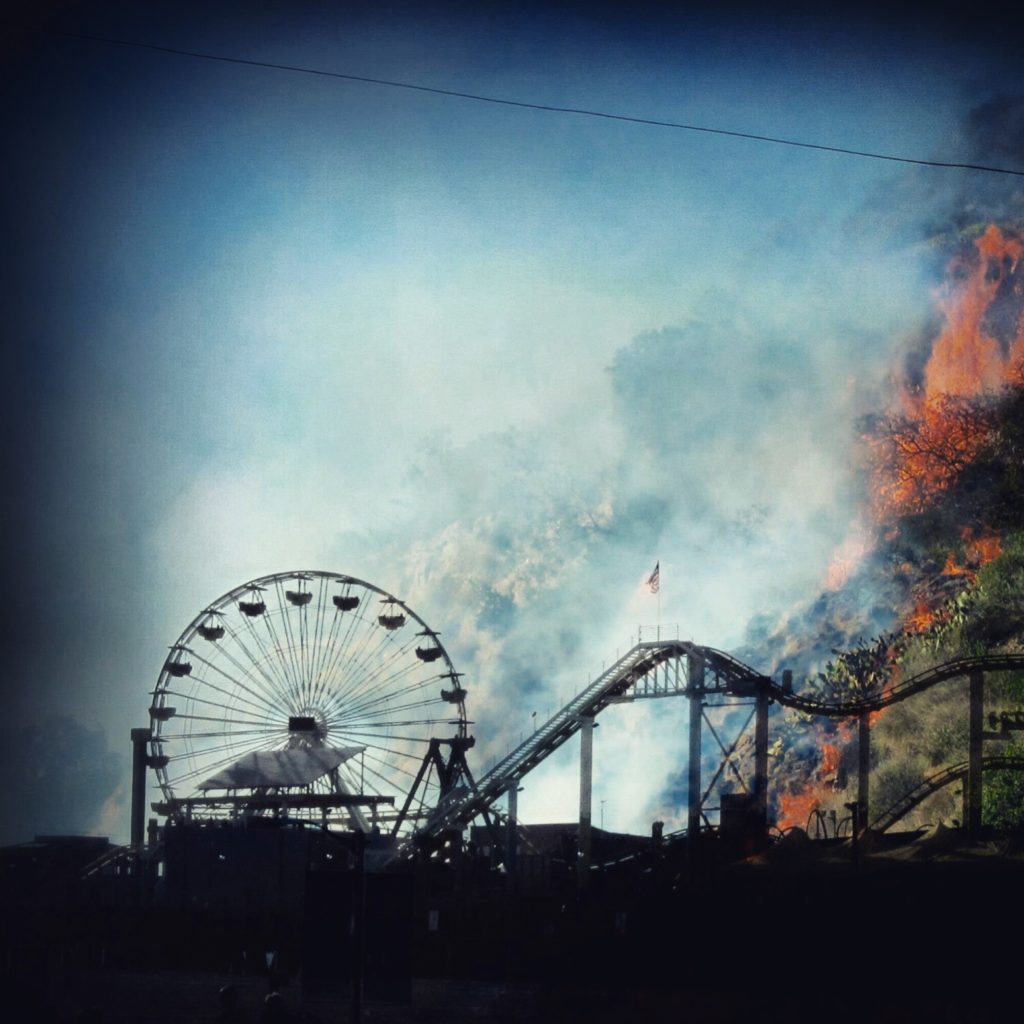
Los Angepocalypse
“The city burning is Los Angeles’s deepest image of itself.” — Joan Didion, Slouching Towards Bethlehem
“Every American city boasts an official insignia and slogan. Some have municipal mascots, colors, songs, birds, trees, even rocks. But Los Angeles alone has adopted an official nightmare…” — Mike Davis, Ecology of Fear
Course Description
An apocalypse signifies the complete, final destruction of the world. But how and why does an apocalypse happen? The Book of Revelations identifies the four horsemen—Pestilence, War, Famine, and Death—as the signs of apocalypse, but there are more subtle warning signs that precede the end of the world as we know it. Literature, film, and television have often used Los Angeles as a site for exploring those more nuanced signs, causes, and effects of the apocalypse. In this course, we will explore warning signs as they appear in a variety of texts that revolve around some kind of apocalypse, whether it be global or local, societal or personal.
Apocalyptic Los Angeles is at once familiar and strange. LA’s downfall in novels, films, and television shows is often the result of natural disaster, riots, ever-escalating class conflict, or any combination of the three. This course will follow the arc of any good disaster film. We will begin by establishing normalcy so that we can understand Los Angeles pre-apocalypse. First, Paul Beatty’s The White Boy Shuffle will introduce us to neighborhood tensions and racism in LA that escalates to the point of an identity crisis, setting the stage for impending chaos. After we get the lay of the land, we’ll move on to the more surreal texts like The Tropic of Orange and The People of Paper, whose many protagonists tell a communal story of Los Angeles as it begins to fall to pieces. Finally, we’ll close with Octavia Butler’s Parable of the Sower, a dystopian future vision of LA as it exists after the apocalypse. Our novel reading will be punctuated by the films Blade Runner and Elysium, both of which present life in post-apocalyptic Los Angeles, as well as selected episodes of Fear The Walking Dead, the brand new AMC show set in LA.
Just as important as exploring how a world arrives at the apocalypse is considering how the world survives the apocalypse. If we make it out alive, do we rebuild? What does a post-apocalyptic city look like? How are people affected by the ultimate destruction? Our texts will give us a few clues and along the way, we’ll read criticism by Mike Davis and others who write about the bristling cityscape that we call home.
Required Books
- Beatty, Paul. The White Boy Shuffle. New York: Picador, 1996. 978-0312280192
- Plascencia, Salvador. The People of Paper. Orlando: Harcourt, 2005. 978-0156032117
- Yamashita, Karen Tai. Tropic of Orange. Minneapolis: Coffee House Press, 1997. 978-1566890649
- Butler, Octavia. Parable of the Sower. New York: Warner Books Edition, 1993. 978-0446675505
- Additional readings will include poems by Wanda Coleman and Garrett Hongo and excerpts of criticism by Mike Davis, Kristin Miller, Dayna Tortorici.
Required Film/television
- Dir. Ridley Scott. Blade Runner (film)
- Dir. Neill Blomkamp. Elysium (film)
- Robert Kirkman & David Erickson. Fear The Walking Dead (television)

Violence in the Deserts of the American West
“The life, too, on the desert is particularly savage. It is a show of teeth in bush and beast and reptile… Everything is at war with its neighbor, and the conflict is unceasing.” — John C. Van Dyke, The Desert
Course Description*
*I designed this course in the fall of 2014 and if I were to teach this class again I would do it entirely different. The following course description and reading list reflects a version of myself that had been taught to uphold the white, Western canon above all else. But the desert is both historically and currently anything but a white space. It’s been settled by white colonizers, and this course reflects that, but in the future I would necessarily emphasize the violence of that settling, and would teach indigenous and Latinx writers, whose voices speak far more accurately to the formation of the deserts of the American West, the violence of settler colonialism, and the the lives actually lived in the desert.
The desert—vast and seemingly infertile—has been constructed in film and literature as a place that notoriously houses outlaws, “criminals,” and those who can’t find lives within the communities offered by more densely populated areas of the country. What is it that inspires writers and filmmakers to create characters who commit acts of unspeakable violence in the desert? Are the inhabitants of the desert in American literature, film, and television simply blood thirsty, or is there something more to their characters and to cultural constructions of the desert that might offer us insight into these portrayals?
This course begins with Cormac McCarthy’s Blood Meridian, in which a band of vicious men set out to annihilate all other human beings in sight, leaving behind a trail of blood that spans hundreds of miles and multiple centuries. Among the sand and scrub of Nevada, the characters in Claire Vaye Watkins’ collection of short stories, Battleborn, face domestic violence, assault, and suicide as part of their daily lives. We’ll also read Michael Ondaatje’s The Collected Works of Billy the Kid, which recalls the mythology behind the real life outlaw who was at once a killer and a lovesick child. The semester will end with Rachel Kushner’s novel The Flamethrowers, following the main character Reno as she races her motorcycle through the desert and tries to escape the weight of her own existence.
We will explore these themes of desert violence and the rhetoric that constructs the desert as void, barren, and empty through the lens of a variety of fictional and non-fictional texts, episodes of Breaking Bad, a film about the disastrous Salton Sea in the heart of the Imperial Valley, and excerpts from cultural and literary critic John Beck’s work Dirty Wars.
Required Books
- McCarthy, Cormac. Blood Meridian. NY: Vintage, 1992. Print. 978-0-679-72875-7
- Watkins, Claire Vaye. Battleborn. NY: Penguin, 2012. Print. 978-1-59463-145-0
- Ondaatje, Michael. The Collected Works of Billy the Kid. NY: Vintage, 1996. Print. 0-679-76786-X
- Didion, Joan. Slouching Towards Bethlehem. NY: Farrar, Straus, and Giroux, 2008. Print. 978-0-374-53138-6
- Kushner, Rachel. The Flamethrowers. NY: Scribner, 2013. Print. 978-1-4391-4201-1
- Additional readings will include excerpts of criticism by John Beck.
Required Film/television
- Dir. Alma Har’el. Bombay Beach (film)
- Dir. P.T. Anderson. There Will Be Blood (film)
- Vince Gilligan. Breaking Bad (television)

